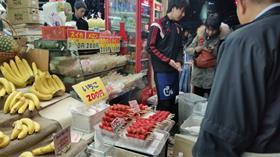
Japan’s average household consumption of fresh fruit has averaged the lowest or second lowest for each month in 2017 since records began being kept 13 years ago, according to data from Japan’sMinistry of Internal Affairs and CommunicationsStatisticsBureau.
The average expenditure on fruit, however, has remained relatively stable in the first six months of the year, with the monthly purchasing price of fruit recorded as the second or third highest for each month.
Bananas remain the leading fresh fruit in terms of expenditure and consumption, with the average household spending ¥442 (US$4) on bananas in June 2017, purchasing an average of 1.76kg at a price of ¥251 (US$2.27) per kg.
Expenditureon kiwifruit was the third highest recorded for June, at ¥234(US$2.12) per household, consuming an average of 283g of kiwifruit, at a purchasing price of ¥826 (US$7.48) per kg.
Overall, expenditure and consumption of grapes has been increasing during Japan’s winter months in the past few years, though has remained relatively stable during the summer months. The average household spent ¥124 (US$1.12) on grapes, buying 100g of grapes during June 2017, at a purchasing price of ¥1,198 (US$10.85) per kg – this highest recorded for that month.
Grapefruit consumption continued to fall, with expenditure reaching the lowest recorded for June at ¥41 (US$0.37), and consumption reaching a low of 100g, while the purchasing price reach a record high of ¥400(US$3.62) per kg.
This story was amended on 4 August, 2017



